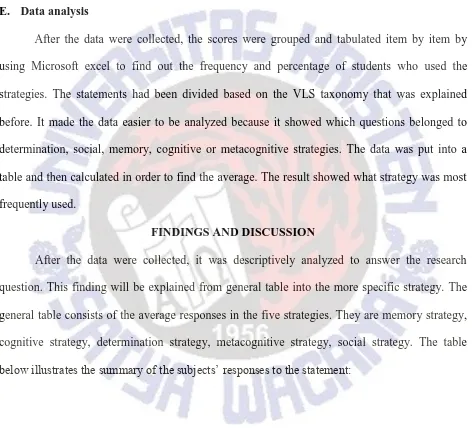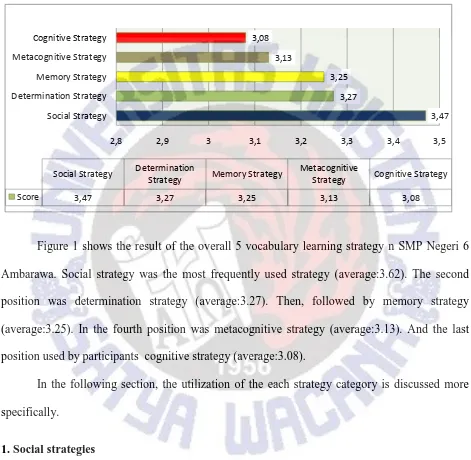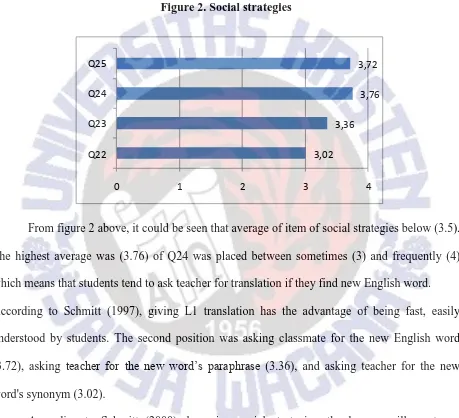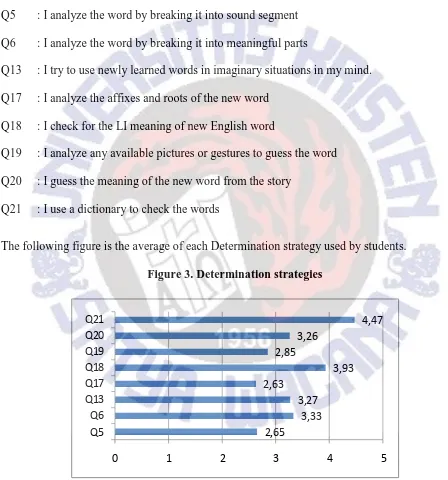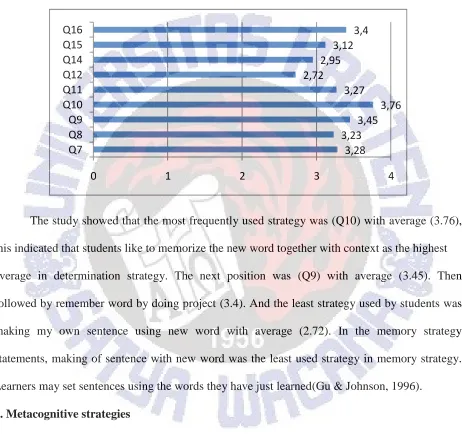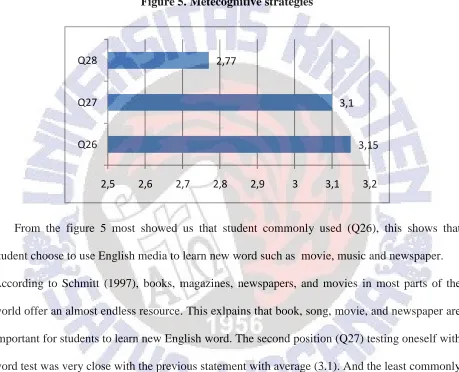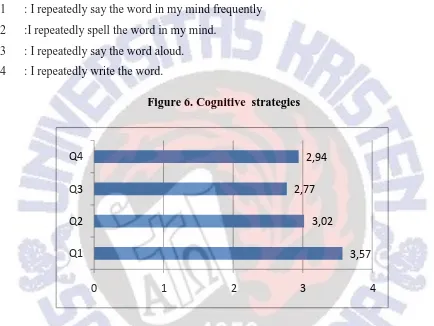Vocabulary Learning Strategy by students
in SMP 6 Ambarawa
THESIS
Submitted in Partial Fulfillment Of Requirments for Degree of
Sarjana Pendidikan
Arif Primadi 112007180
ENGLISH TEACHER EDUCATION PROGRAM FACULTY OF LANGUAGE AND LITERATURE SATYA WACANA CHRISTIAN UNIVERSITY
Vocabulary Learning Strategy by students
in SMP 6 Ambarawa
THESIS
Submitted in Partial Fulfillment of the Requirements for the Degree of
Sarjana Pendidikan
Arif Primadi 112007180
Approved by:
Anne Indrayanti Timotius, M.Ed. Prof.DR. Gusti Astika,M,A,
COPYRIGHT STATEMENT
This thesis contains no such material as has been submitted for examination in any course or accepted for the fulfillment of any degree or diploma in any university. To the best of my knowledge and my belief, this contains no material previously published or written by any other person except where due reference is made in the text.
Copyright@ 2014. Arif Primadi and Anne Indrayanti Timotius, M.Ed.
All rights reserved. No part of this thesis may be reproduced by any means without the permission of at least one of the copyright owners of the English Teaching Education Program, Faculty of Language and Literature, Satya Wacana Christian University, Salatiga.
1
PUBLICATION AGREEMENT DECLARATION
As a member of the (SWCU) Satya Wacana Christian University academic community, I verify that:
Name : Arif Primadi
Student ID Number : 112007180
Study Program : English Teaching Education Program Faculty : Language and Literature
Kind of Work : Undergraduate Thesis
In developing my knowledge, I agree to provide SWCU with a non-exclusive royalty free right for my intellectual property and the contents therein entitled:
Vocabulary Learning Strategy by students in SMP 6 Ambarawa along with any pertinent equipment.
With this non-exclusive royalty free right, SWCU maintains the right to copy, reproduce, print, publish, post, display, incorporate, store in or scan into a retrieval system or database, transmit, broadcast, barter or sell my intellectual property, in whole or in part without my express written permission, as long as my name is still included as the writer.
This declaration is made according to the best of my knowledge.
Made in : Salatiga
Date :
Verified by signee,
Arif Primadi
Approved by
Thesis Supervisor Thesis Examiner
2
Vocabulary Learning Strategy by students
in SMP Negeri 6 Ambarawa
Arif Primadi
Abstract
English vocabulary has important role in English learning. In order to help students to increase vocabulary easier we need to know and learn strategy that students use in learning
vocabulary. This study evaluates the use of strategy in junior high school. By doing this, it is assumed that students and teacher will get the benefit of this study. Based on Schmitt vocabulary
learning strategy, there are five different categories of vocabulary learning strategies such as determination strategy, social strategy, memory strategy, cognitive strategy, and metacognitive strategy. These categories cover an overall 28 statements in a form of questionnaire that is
adopted from Schmitt (1997) taxonomy of vocabulary learning strategy and Cheung (2004). There were 95 students of grade 8 and 9 in SMP Negreri 6 Ambarawa participated in this study.
The data were analyzed by using descriptive statistic. The finding of this study showed that Social strategy is the most frequently used strategy in SMP Negeri 6 Ambarawa.
1 Introduction
Today English is becoming more and more popular all over the world. According to Nga
(2008), English is not only considered as the mother tongue of about more than 60 million speakers in many countries, but also used widely in the world as an international language. As what we see that people do really need study English as a need and learners must be aware of the
need of English in school or in real life.
Vocabulary has been considered central to the development language proficiency. The
most pressing need of people learning another language is vocabulary (Laufer, 2003). Learners need to have good ability in order to express themselves in language. In addition, Schmitt (1997) states that vocabulary learning strategies are even more important in second language learning in
order to expand proper learning strategies for long term learning, because it is impossible acquiring a languange without being master in vocabulary.
In their journal, Khafipour and Naveh (2011) suggest that poor vocabulary has created communication problems for language learners. If they do not have sufficient English
vocabulary, it would be difficult for them to explore and develop English as a foreign language.
Wilkin (1972) agrees when he states “while without grammar very little can be conveyed, without vocabulary nothing can be conveyed” (p.111). In addition, Cheung (2004) said that
vocabulary represents a serious problem to determine how learners could learn English vocabulary effectively. This statement shows us that learning vocabulary is one of the most
important things in learning a language.
2
language or a list of set of words that individual speakers of language might use” (p.1). In
addition, Brekelet (2003) stated that vocabulary is “a list of words like the one found in
dictionary of glossary or lexicon, which includes all the words of a language and known or used
by person or group”. From those quotes, basically vocabulary refers to words which have
meaning.
In order to make learning vocabulary easier, there should be a strategy as a tool to accomplish learning. According to O’mallyand Chamot (1990) “special thoughts and behaviours that individuals use to help them comprehend, learn, or retrieve information” (p1.). Another
argument from Rubin (1987) quoted from Xiang (2009) states “learning strategies are strategies that contribute to development of the system which the learner constructs and affects learning directly” (p.22). A strategy needs to be applied in many aspect of learning especially in learning
vocabulary. This is because as what Wenden (1998) states “language learning strategy as mental steps or operation that learners that use to learn a new language and to regulate their efforts to do so”. And what O’Malley and Chamot (1990), confirm that most language learning strategies are used for vocabulary learning tasks. So, one way to help learners to enhance their knowledge of second language vocabulary is through equipping learners with a variety of vocabulary learning strategies.
In 1994, Gu conducted a study which showed that strategies are used by second language
learners for the acquisition of new word in second language are called “vocabulary learning
strategies. Khafipour and Naveh (2011) also said that utilization of vocabulary learning strategies
has been found to affect students’ performance in language learning strategy”. In their research,
3
ways of doing it. Those special ways are known as learning strategies, and these learning
strategies can help the students learn language easily.
Recent study in second language learning indicates that “English learner could learn
different learning strategies to learn English to enhance learning efficiency” (Yang, Haggard, &
Li, 2008). Xiang and Srikhao (2009) concludes that students in Miao, China who employed
English vocabulary learning strategy influence and promote English learning. Another study
from Asgari dan Mustapha (2011) states that teacher who use different vocabulary techniques
can impart to students to promote vocabulary learning.
Another research was conducted by Hamzah, Kafipour, and Abdullah (2009). They
investigated Iranian ungraduate EFL learners’ vocabulary learning strategies. They use two kinds
of instruments, they are from Schmitt’s (1997) vocabulary learning strategy questionnaire and
Nation’s (2001) standardized vocabulary test. Result shows that most frequently used is
cognitive and meatacognitive is the following. For the least strategy used are social strategies
and memory strategies.
Moreover, Chamot and Kupper (1989) suggest that learning strategies instruction may
help learner in three ways, first, learning strategies instruction can help students to be better
learners. Second, skill in using learning strategies aids them to become independent and
confident learners. The last is they become more motivated as they begin to understand the
relationship between the use of strategies and success in learning languages.
However, students who use strategy in learning are not always being succeeded. Some
research shows many learners are unsuccessful using learning strategies. Weinsten (1987) says
that age, degree of awareness, and duration become the factors that can influence the learners’
4
the reason why the learners are unsuccessful in using the strategies is that they do not have the
ability in choosing the right strategies for the task. Besides, they did not try to use the words they
have known before in their speaking or writing activity. They often rely on their first-language
translation of the words. The best way to help them is by discussing the best strategy that can be
used to finish the task
In addition, Asghari and Mustapha (2010) quoted form Schmitt (1997) defines five
sub-categories of vocabulary learning strategy:
1. Determination strategy
It is individual learning strategy. Included in determination strategies are analyzing
the unknown word, its constituent elements, or the surrounding context to determine the meaning. If they lack of guessing words, dictionary is the best way in order to offer the learner better quality of information.
2. Social strategy
It engages learners to learn new word through interaction with others. and these
strategies help them to learn from each other, such as observing their classmates and
asking their teacher for the meaning of a word.
3. Memory strategy
It is the strategy, which engages a learner in learning the new word through mental
processing by associating background knowledge with the new word. For example,
when the learner come across the word “cats”, the learners will group word “cat”
under the category of a four-legged animals because learner already know the image
of these four-legged animals from his/her background knowledge. Another example
5
name of the sport because he/she already remembers the actions associated with that
sport.
4. Cognitive strategy
It is the strategy that is used for linking new information with existing schemata and
for analyzing in its classifying. It deals with mechanical aspects of learning
vocabulary and it is not related to mental processing. Repetition is one of the most
commonly used cognitive strategies. Other examples are taking notes and
highlighting new words, making lists of new words, using flashcards to record new
words, putting English labels on physical objects, keeping a vocabulary notebooks,
and writing the words many times.
5. Metacognitive strategy
It is the strategy that learners develop an awareness of their own learning and how
they are able to improve most efficiently. Metacognitive strategy related to processes involving monitoring, decision-making, and evaluation of one’s progress.
Metacognitive strategies help the learner in determining appropriate vocabulary
learning strategies for learning new words.
As what Brown and Perry (1991) stated that recent studies in second language
vocabulary learning indicated that the students who use vocabulary learning can learn more
effectively than those who do not use the strategies. This clearly stated that students who attempted vocabulary learning strategy could learn more effectively than students who did not
6
strategy would accommodate student in Senior High School to gain their ability so that, they can
make better progress in learning vocabularies.
In this study, the researcher analyzed the strategies and what kind of strategies were used by the students in SMP Negeri 6 Ambarawa in order to make specific which strategy those
students used most. Based on the discussion above this study was conducted to answer the
research question that is “What is the most frequently used vocabulary learning strategies by students in SMP Negeri 6 Ambarawa?”. Since, it is believed that Vocabulary has very important role in learning language especially English. The result of this study is expected will provide information for the teacher to help student to acquire much English vocabulary, so that the
students can become better learners in English. Another benefit of the study is for teacher to design suitable material in order to accommodate students’ need based on the result of the study.
The Study A. Context of study
The research was conducted in SMP Negeri 6 Ambarawa, Kabupaten Semarang, Central Java, Indonesia. The students in SMP Negeri 6 Ambarawa came from around Ambarawa.
Before the school was built, many students did not continue their study in Junior High, it means that they only finished study until Elementary School. In the beginning of 2008 until 2011, the
name of school was SMP SATU ATAP. Students and teacher used Elementary school building because they only had one classroom. The main reason of choosing SMP Negeri 6 Ambarawa
7 B. Participant
The participants were Students from grade 8th and 9th in SMP Negeri 6 Ambarawa. Those clasess consisted of 103 students, 25 students belonged to 8A, 24 students belonged to 8B, 24.
Students belonged to 9A, and 22 Students belonged to 9B. However, only 95 students filled the questionnaires because the other 8 students were absent. The reason why the researcher chose those participants was because many of them started learning English with qualified English
teacher in Junior high school. Some Elementary schools near SMP Negeri 6 Ambarawa used Non - English teacher to teach English.
C. Instrument of data
A twenty eight statement questionnaire was distributed to students as the instrument of data collection. The statements were adapted from Schmitt (1997) taxonomy of vocabulary learning
strategy and Cheung (2004). As students’ first language was Indonesian, the statements were translated into Indonesian to avoid misunderstanding. There were 28 statements given, four
statements on cognitive strategies, eight statements on determination strategy, Nine statements on memory strategies, four statements on social strategies, and three statements on metacognitive strategies. The frequency of use were measured by 5 point Likert scales (never, rarely,
sometimes, frequently, and always).
D. Procedures of data collection
After the questionnaires were made, the researcher piloted the questionnaire. There were five students from 8 graders from SMP Negeri 1 Jambu. Three of them easily answered the questionnaire and the rest two students had problems with statements number 5,6, and 17.
8
SMP Negeri 6 Ambarawa to ask permission from principle to conduct research. In distributing questionnaires, researcher was accompanied by guru piket. Researcher came to four classes
(grade 8 and grade 9) and explained what students should do and then distributed the questionnaire. It took less than 60 minutes to get the data.
E. Data analysis
After the data were collected, the scores were grouped and tabulated item by item by
using Microsoft excel to find out the frequency and percentage of students who used the
strategies. The statements had been divided based on the VLS taxonomy that was explained before. It made the data easier to be analyzed because it showed which questions belonged to
determination, social, memory, cognitive or metacognitive strategies. The data was put into a table and then calculated in order to find the average. The result showed what strategy was most frequently used.
FINDINGS AND DISCUSSION
After the data were collected, it was descriptively analyzed to answer the research
question. This finding will be explained from general table into the more specific strategy. The
general table consists of the average responses in the five strategies. They are memory strategy,
cognitive strategy, determination strategy, metacognitive strategy, social strategy. The table
9 A. Overall Result
Figure 1. The Overall Result of Vocabulary Learning Strategies
3,47
Figure 1 shows the result of the overall 5 vocabulary learning strategy n SMP Negeri 6
Ambarawa. Social strategy was the most frequently used strategy (average:3.62). The second position was determination strategy (average:3.27). Then, followed by memory strategy (average:3.25). In the fourth position was metacognitive strategy (average:3.13). And the last
position used by participants cognitive strategy (average:3.08).
In the following section, the utilization of the each strategy category is discussed more
specifically.
1. Social strategies
Social strategies use interaction with other people to improve language learning
(Schmitt,1997). Below, there are three statements used to investigate the use of social strategies. Q22: I ask new word's synonym to teacher
10 Q24: I ask new word’s translation to teacher Q25: I ask meaning of the word to classmate
The following figure is the average of each Social strategy used by the students
Figure 2. Social strategies
From figure 2 above, it could be seen that average of item of social strategies below (3.5). The highest average was (3.76) of Q24 was placed between sometimes (3) and frequently (4)
which means that students tend to ask teacher for translation if they find new English word. According to Schmitt (1997), giving L1 translation has the advantage of being fast, easily understood by students. The second position was asking classmate for the new English word
(3.72), asking teacher for the new word’s paraphrase (3.36), and asking teacher for the new word's synonym (3.02).
According to Schmitt (2000), by using social strategies, the learner will create an interaction with their friends and they can learn from each other. This study indicated that most students in this study were social learner. They really depended on their teacher and classmates.
3,02 3,36
3,76 3,72
0 1 2 3 4
11 2. Determination strategy
Determination Strategy is strategy that have by learnes to help them to know the meaning of the
word by using their knowledge without help of other people (Schmitt, 2000). Below, there are three statements used to investigate the use of determination strategies.
Q5 : I analyze the word by breaking it into sound segment Q6 : I analyze the word by breaking it into meaningful parts
Q13 : I try to use newly learned words in imaginary situations in my mind.
Q17 : I analyze the affixes and roots of the new word Q18 : I check for the LI meaning of new English word
Q19 : I analyze any available pictures or gestures to guess the word Q20 : I guess the meaning of the new word from the story
Q21 : I use a dictionary to check the words
The following figure is the average of each Determination strategy used by students.
12
From the figure 3 above, the strategy of using dictionary to check the word (Q21) had the highest average (4.47). (4.47) means that opening dictionary was placed between frequently (4)
and always (5). According to Schmitt (1997), bilingual dictionaries was inferior to that available in their monolingual counterparts. In dictionary students can find the exact meaning of new
word. So that, dictionary is the most frequently used strategy in determination strategy. In the second position it was strategy (Q18) with average (3,93), and then followed by (Q6) with average (3.33). In the fourth position there was (Q13) with strategy “I try to use newly learned words in imaginary situations in my mind”, In the least position was analyzing affixes and roots of new word (Q17) with average (2.63) which means that the students were not familiar with
affixes and roots. Students tend to use dictionary rather than other strategies. This shows that students are more comfortable using dictionary. Schmitt (1997) also said that determination strategies are used when the learners are faced with discovering a new word’s meaning without recourse to another person’s experience.
3. Memory strategies
According to Schmitt (2000), memory learning strategies is strategies that connect with the learners by doing mental processing and relating the word with some background knowledge
by using some form of imagery or grouping. ). Below, there are three statements used to investigate the use of memory strategies.
Q7 : I link the word to a visual image in my mind.
Q8 : I link the word to another English word with similar sound. Q9 : I link the word to an Indonesian word with similar sound Q10 : I remember the sentence in which the word is used
Q11 : I remember the new word together with the context where the new word occurs. Q12 : I make up my own sentences using the new word.
13
Q15 : I remember words by doing group work activities in class. Q16 : I remember words by doing project
The following figure is the average of each Memory strategy used by students.
Figure 4. Memory strategies
The study showed that the most frequently used strategy was (Q10) with average (3.76), this indicated that students like to memorize the new word together with context as the highest
average in determination strategy. The next position was (Q9) with average (3.45). Then followed by remember word by doing project (3.4). And the least strategy used by students was
making my own sentence using new word with average (2.72). In the memory strategy statements, making of sentence with new word was the least used strategy in memory strategy. Learners may set sentences using the words they have just learned(Gu & Johnson, 1996).
4. Metacognitive strategies
According to Oxford (1990), metacognitive strategies involve a conscious overview of
14
Q26 : I use English media (song, movie,newscast) to learn new word Q27 : Testing oneself with word test
Q28 : Continue to study word over time
The following figure is the average of each Metacognitive strategy used by students.
Figure 5. Metecognitive strategies
3,15 3,1 2,77
2,5 2,6 2,7 2,8 2,9 3 3,1 3,2
Q26 Q27 Q28
From the figure 5 most showed us that student commonly used (Q26), this shows that
student choose to use English media to learn new word such as movie, music and newspaper. According to Schmitt (1997), books, magazines, newspapers, and movies in most parts of the
world offer an almost endless resource. This exlpains that book, song, movie, and newspaper are important for students to learn new English word. The second position (Q27) testing oneself with word test was very close with the previous statement with average (3.1). And the least commonly
15 5. Cognitive study
This study discovered that the students also use cognitive strategy in their learning process.
They did practice in order to remember English word longer. There were four statements that were used by student in learning vocabulary.
Q1 : I repeatedly say the word in my mind frequently Q2 :I repeatedly spell the word in my mind.
Q3 : I repeatedly say the word aloud. Q4 : I repeatedly write the word.
Figure 6. Cognitive strategies
3,57 3,02
2,77 2,94
0 1 2 3 4
Q1 Q2 Q3 Q4
Figure 6 illustrates that the students used (Q1) “I repeatedly say the word in my mind frequently” was the most frequently used with average (3.57). The second position was (Q2) with average (3,02). While in the last position statement (Q3) “I repeatedly say the word aloud”. This
result shows that students were not confident enough to say the word aloud which can also help
them mastering in pronunciation. Schmitt (1997) said that cognitive strategies are not focused on manipulative mental processing. It was also proven by the theory that, repeatedly say the word in
16
CONCLUSION
The purpose of this research was to explore the most frequently used vocabulary learning
strategy used by students in SMP Negeri 6 Ambarawa , Kabupaten Semarang, Central Java. From the data analysis and interpretation, the most frequently used strategies were (1) asking teacher for new word’s translation, (2) using dictionary to check new word, (3) remembering the
sentence in which the word is used, (4) using English media (song, movie, newscast and etc) to learn new word, (5) repeating the word in mind frequently.
After conducting this research, I found that asking teacher for the new English word was the most frequently use strategy in SMP Negeri 6 Ambarawa. By doing this, students easily and
quickly get the meaning. According to Schmitt (1997), giving L1 translation has the advantage of being fast, easily understood by students and make possible transfer of all the knowledge a student of the L1 word onto the L2 equivalent. Furthermore, using dictionary to check the word
meaning can give the exact meaning of the new word. Students can use it whenever they need it. Based on the findings, the researcher drew the following conclusion. The rank of vocabulary
learning strategy employed by the subject from highest to the lowest was social strategy, determination strategy, memory strategy, metacognitive strategy and cognitive strategy. Social strategy was the most frequently used strategy in SMP Negeri 6 Ambarawa.
According to the conclusion, the researcher provided some implications for student and teacher. First, teacher can introduce set of vocabulary learning strategy to student. By doing this,
student will be aware of existence and function of vocabulary learning strategies. Second, students can learn different strategies based on students’ majority. Then, teacher can choose suitable strategies for students. It is hoped that student can improve their vocabulary learning
17
Future studies on vocabulary learning strategy hoped can use both qualitative and quantitative method. Those methods will give a clearer point of view of student strategy. In this
18 References
Asgari, A., & Mustapha, G. B. (2011). The type of vocabulary learning strategies used by ESL studies in University Petra Malaysia. English Language Teaching, 4, No 2, 84-90.
Brekelet ,L. S, Panozzo, J., Pascoe, C., &Zepeda,G.(2003). Vocabulary development.Retrieved February 22, 2012 from http://nevadera.org
Brown, T. S., & Perry, F. L. (1991). A Comparison of Three Learning Strategies for ESL Vocabulary Acquisition. TESOL QUARTERLY, 25, 661 - 670.
Chamot, A. U & Kupper, L. (1989).Learning strategies in foreign language instruction.Foreign language annals 22, 13-24.
Cheung, C.Y. (2004). The effectiveness of vocabulary learning strategies of Chinese low achievers.Unpublished master’s thesis, The University of Hong Kong, Hong Kong.
Gu, P.Y. (1994). Vocabulary Learning in a Second Language: Person, Task, Context, Strategies.
Teaching English as a Second or Foreign Language TESL-EJ , 7 (2).
Hamzah, S. G., Kafipour, R., & Abdullah, S. K. (2009). Vocabulary learning strategies of Iranian ungraduate students and its relation to their vocabulary size. European Journal of Social Sciences , 39-50.
Hatch & Brown (1995).Vocabulary,semantics , Language Education. New York: Cambridge University Press.
Kafipour, R., Naveh, M.M. (2011). Vocabulary learning strategies and their contribution to reading comprehension of EFL undergraduate students in Kerman Province. Europaean Journal of Social Sciences,
Laufer, N. (2003) Learning style preferences of ESL students, TESOL Quarterly, 21, 87- 112.
Macintyre, P.D. (1994). Variables underlying willingness to communicate : A casusal analysis.
Communication Research report, 11, 135-142.
Nation, I. (2001). Learning Vocabulary in Another Language. Cambridge: Cambridge Unversity Press.
Nga, N. T. (2008). English - A global language and its implications for students. VNU Journal of Science, Foreign Language , 260-266.
O’mally, J. M. & Chammot, A. U. Learning strategies in second language acquisition.
Cambridge: Cambridge University Press, 1990.
19
Rasekh, Z. E. & Ranjbary, R. (2003). Metacognitive strategy training for vocabulary learning.
Teaching English as a Second or Foreign Language, 7(2), 1-15.
Schmitt, N. (2000). Vocabulary in language teaching. Cambridge University Press, Cambridge.
Schmitt, N. (1997). Vocabulary learning strategies. In Schmitt, N. and M.McCarthy (Eds.)Vocabulary: Description, Acquisition, and Pedagogy (pp. 199-227). Cambridge: Cambridge University Press.
Wenden,A., Learner strategies for learner autonomy. New York: Prentice Hall, 1991.Twenty Eight Annual Convention and Exposition (p.27). Baltimore
Weinsten, C. E., 1987, LASSI: Learning and study strategies inventory, Clearwater, FL:H and H Publishing.
Wilkins,D.A., Linguistic in Language teaching. London: Edward Arnold Ltd, 1972
Xiang, P. S., & Srikhao, S. (2009). English vocabulary learning strategy of senior high school students in china. International Postgraduate Research Colloquium , 75-82.
20
Kuesioner
Kuesioner ini bertujuan untuk pengumpulan data yang akan digunakan dalam penelitian
mengenai sikap siswa terhadap pembelajaran kosakata. Untuk melindungi hak pribadi responden, nama Anda dalam kuesioner ini tidak akan dicantumkan dalam laporan penelitian. Jawaban yang Anda berikan tidak akan mempengaruhi nilai rapor Anda.
Nama : ... Kelas : ...
Jenis kelamin : ...
Berilah tanda centang (√) pada kolom sesuai pendapat Anda. (Selalu, Sering, Kadang-kadang, Jarang, Tidak pernah). Kuesioner ini digunakan untuk mengetauhi tingkat pembelajaran kosakata anda dalam belajar Bahasa Inggris.
No.
Statements
1. Saya mengucapkan kata di pikiran saya berulang ulang.
2. Saya mengeja kata di pikiran saya berulang ulang.
3. Saya mengatakan kata dengan keras (lantang) berulang ulang.
4. Saya menulis kata berulang ulang.
5.
Saya menganalisa kata dengan membaginya menjadi kategori pengucapan.
21
Saya menganalisa kata dengan memilahnya ke bagian yang penting.
(Contoh : birth-day)
7. Saya menghubungkan kata dengan gambaran dipikiran saya.
8.
Saya menghubungkan kata dengan kata yang lain yang mempunyai pengucapan yang sama.
(Contoh : Family/Familiar, Goat/Coat)
9. Saya menghubungkan kata dengan Bahasa Indonesia yang mempunyai pengucapan yang sama.
10. Saya mengingat kalimat dimana kata itu digunakan.
11. Saya mengingat kata baru bersama dengan konteks dimana mendapati kata baru.
12. Saya membuat kalimat sendiri dengan kata baru.
13. Saya mencoba menggunakan kata yang baru dipelajari dengan membayangkannya di pikiran.
14. Saya mengingat kata dengan cara mendikte.
15. Saya mengingat kata dengan kerja kelompok dikelas.
16. Saya mengingat kata dengan mengerjakan tugas.
17.
Saya menganalisa imbuhan (affixes) dan kata dasar (roots) dari kata baru.
22
18. Saya mencari arti dalam Bahasa Indonesia dari kata Bahasa Inggris yang baru.
19. Saya menganalisa berbagai gambar atau gerakan tubuh untuk menebak kata.
20. Saya menebak arti kata baru di bacaan (cerita).
21. Saya menggunakan kamus untuk memeriksa arti kata .
22. Saya bertanya sinonim pada guru untuk kata baru.
23. Saya bertanya pada guru untuk phrasa baru.
24. Saya bertanya pada guru untuk arti kata yang baru.
25. Saya bertanya teman untuk arti kata baru.
26.
Saya menggunakan media untuk belajar kata baru. (Lagu, film, koran dan lain lain)
27. Saya mengetes kata pada diri saya sendiri
